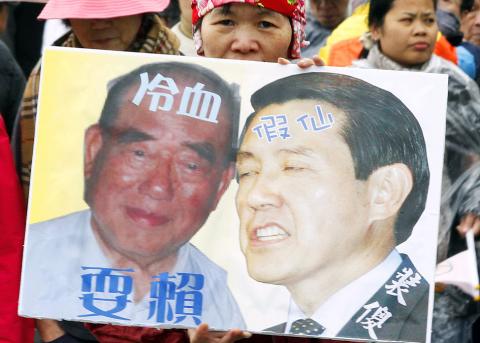|
Hau Pei-tsun lacks common sense, Lin
I-hsiung says
Staff Writer, with CNA

An activist holds a placard
depicting President Ma Ying-jeou, right, and former premier Hau Pei-tsun at a
rally to mark the 65th anniversary of the 228 Incident in Taipei yesterday. The
characters read: ¡§Cold blood,¡¨ ¡§fooling around,¡¨ ¡§cheating¡¨ and ¡§playing dumb.¡¨
Photo: Shengfa Lin, Reuters
Former Democratic Progressive Party
chairman Lin I-hsiung (ªL¸q¶¯) yesterday said former premier Hau Pei-tsun (°q¬f§ø)
lacked common sense when he questioned the number of deaths in the 228 Massacre.
¡§Mr Hau Pei-tsun was a representative of the ruling regime and he shouldn¡¦t have
made such comments,¡¨ Lin said after a memorial service for victims of the
massacre.
¡§He should have approached the subject in a more discreet manner,¡¨ Lin said.
Hau, a general-turned-politician who served as premier from 1990 to 1993,
questioned in an op-ed published in the Chinese-language United Daily News (UDN)
on Feb. 21 whether ¡§more than 10,000 were killed¡¨ in the massacre, as is stated
in a school textbook.
Hau said that when he was premier, a government task force convened to address
the issue concluded that only about 1,000 people had put in claims for
compensation as victims of the massacre.
Academics and victims¡¦ families have estimated that more than 10,000 people died
in the Chinese Nationalist Party (KMT) regime¡¦s crackdown on civil unrest and
dissent, which was triggered by a dispute between a cigarette vendor and
officials from the Tobacco Monopoly Bureau on Feb. 27, 1947.
A report commissioned by the Executive Yuan in 1992 when Hau was premier put the
death toll at between 18,000 and 28,000.
Hau¡¦s comments in the UDN sparked outrage among victims¡¦ families, many of whom
participated in a demonstration yesterday to mark the 65th anniversary of the
Incident.
¡§People¡¦s lives are precious; it is wrong to kill even one person,¡¨ Lin said.
The responsible way to approach the issue, Lin said, would be to review how and
why the 228 Incident and ensuing massacre took place and what could have been
done better in the handling of the issue.
¡§These issues should all be discussed as a lesson for future generations and to
prevent similar incidents from reoccurring,¡¨ he said.
Lin¡¦s 60-year-old mother and his seven-year-old twin daughters were stabbed to
death on Feb. 28, 1980, at the Lin residence in Taipei by an unknown number of
assailants. Lin¡¦s eldest daughter was severely injured and was the lone survivor
of the attack.
The murder occurred after Lin had just been arrested for his involvement in the
Kaohsiung Incident, a KMT crackdown on pro-democracy demonstrations in Kaohsiung
on Dec. 10, 1979. Those responsible for the Lin killings were never identified.
|
![]()
![]()
![]()